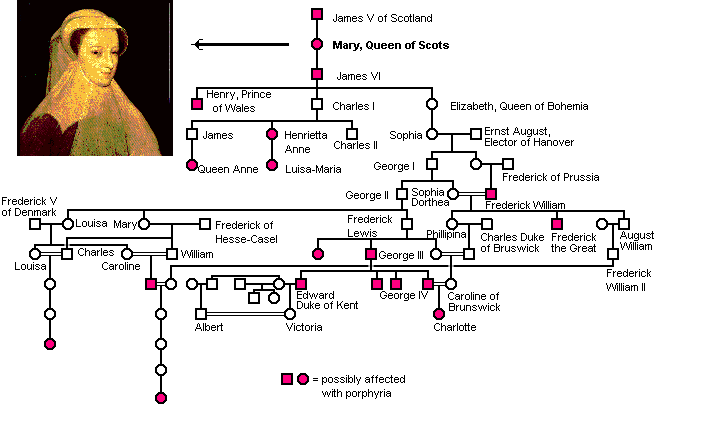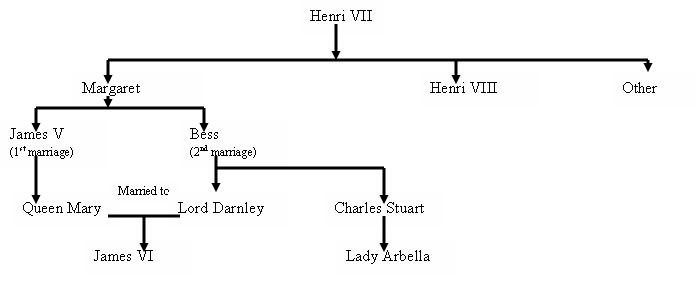Home >Porphyria
Porphyria Navigation: Forword Contents Previous page
Porphyria
The answer is pure curiosity and principle. We know that the son of the Duke of Gloucester i.e. first cousin of Charles Prince of Wales, suffered from Porphyria and had his first attack resulting to a plane crash. The longer the gene is in the family the longer it remains. The picture below showed how many members of the royal family have been affected during the year.

The picture showed that the gene has been present over the years. However, its origin has not been identified.

The above picture showed that two options are available for the illness origin: the Tudor or the Stuart as Angus was a Stuart through Robert III. To eliminate the Stuart and hence the Valois, you need to find no evidence of porphyria in the Tudor through Henri VII and his descendants.
If it was not the Tudor, then it must be the Stewarts
I was going to try obtaining information about the Kings of Scotland up to James IV. However, I found in my local library "Robert the Bruce" by Caroline Bingham. In page 317, there is a reference of a potential stroke and more intriguing is a mention of disfiguration. Furthermore, in page 176, there is a mention that Robert suffered from an unknown illness but recovered a year later. Again those two facts could mean nothing. However, when looking at Robert's genealogy, there are very intriguing facts. The number of mariage between first degree cousins is alarmly high.

The above diagram showed a simplified version of Robert's genealogy. In addition, it is likely that Cecilia was the daughter of 7th Earl of Dunbar not the 5th contrary to most records: the time lag would be too great.
From the above figure, it is possible that Porphyria comes from one the branches.
Further researches could investigate this possibility of Medieval time for the illness origin. It is my belief that the truth is not far from there. However, I do not have the time to do further research.
Note 1: Georges III by Christopher Hibbert Back to the text
Note 2: Georges III's doctor diary to be identified. Back to the text
Note 3: Medline plus information on Porphyria
Back to the text
Note 4: Porphyria foundation
Back to the text
Note 5: Bipolar.com
Back to the text
Note 6: Charles I by James Hibbert: pages 23 and 35.
Back to the text
Note 7: Lady Arbella Stuart by Ruth Norrington.
Back to the text
Note 8: Henry VIII by Jasper Ridley
Back to the text
Note 9: Children of England, the heirs of Henry VIII by Alison Weir
Back to the text
Note 10: Bastard Prince Henri VIII's lost son by Beverly Murphy
Back to the text
Note 11: Henry VII by Roger Turvey and Caroline Steinsberg
Back to the text
Note 12: Marriage with my kingdom by Alison Plowden
Back to the text
Note 13: The sisters of Henri VIII by Maria Perry
Back to the text
Porphyria Navigation: Forword Contents Previous page
Porphyria
3. The Search
3.1 Introduction
The question of this page is: Are the two illnesses connected? The illness of Georges is well documented. The one of Charles VI could be similar to the one of Georges. The two persons are connected genetically. Georges, also an Hanovarian, descends from the Tudor through James I. James I himself decends from Charles VI through Catherine Valois who married Owen Tudor. However, what is the point of the research?The answer is pure curiosity and principle. We know that the son of the Duke of Gloucester i.e. first cousin of Charles Prince of Wales, suffered from Porphyria and had his first attack resulting to a plane crash. The longer the gene is in the family the longer it remains. The picture below showed how many members of the royal family have been affected during the year.

The picture showed that the gene has been present over the years. However, its origin has not been identified.
3.2 The Stuart of Scotland
We do know that note 6James I and his son, Henri, suffered from Porpyria. Henri's first attack was fatal whereas James I suffered continuously from the illness. What is less known is that Lady Arbellanote 7 suffered from Porphyria too. Directly descended from Henry VII through his eldest daughter Margaret Tudor, she was first cousin to James I, niece to Mary Queen of Scots and Lord Darnley and daughter of Darnley's younger brother Charles Stuart and Elizabeth Cavendish, daughter of Bess of Hardwick. Henry Stuart, Lord Darnley, born 7th December 1545 at Temple Newsham in Yorkshire, was the second husband of Mary, Queen of Scots. The second son of Matthew, 4th Earl of Lennox and Lady Margaret Douglas, who was the daughter of Margaret Tudor (sister of Henry VIII) with her second husband, Archibald, 6th Earl of Angus.The above picture showed that two options are available for the illness origin: the Tudor or the Stuart as Angus was a Stuart through Robert III. To eliminate the Stuart and hence the Valois, you need to find no evidence of porphyria in the Tudor through Henri VII and his descendants.
3.3 The Tudor
The problem with the Tudor is that the last Tudors were plagued with illnesses. Edward VI died young as his older brother the Dukes of Richmond and Somersetnote10. Edward VI was not healthy note9. His sisters health were again not the best in the world even for the period note12 and note9. However, there are no evidence that they suffered from porphyria. Their illnesses are well documented in the various biographies. In addition, there are few evidence of mood changes, skin problems or other well known aspect of porphyria. In addition, Henri VII note11 and Henri VIII note8 , his son, never showed any signs of the illness either. However, although Arthur, eldest son of Henri VII, died misteriously, the most likely cause of his death seems cancer in lieu of porphyria note8.If it was not the Tudor, then it must be the Stewarts
3.4 Controversy
I named this paragraph contreversy because I did not want to give the game away. One piece of the puzzle is James IV of Scotland. His mood was swinging. To be fair, it has been assumed that he killed his father and therefore, he could not reconciliate with that factnote13.I was going to try obtaining information about the Kings of Scotland up to James IV. However, I found in my local library "Robert the Bruce" by Caroline Bingham. In page 317, there is a reference of a potential stroke and more intriguing is a mention of disfiguration. Furthermore, in page 176, there is a mention that Robert suffered from an unknown illness but recovered a year later. Again those two facts could mean nothing. However, when looking at Robert's genealogy, there are very intriguing facts. The number of mariage between first degree cousins is alarmly high.
The above diagram showed a simplified version of Robert's genealogy. In addition, it is likely that Cecilia was the daughter of 7th Earl of Dunbar not the 5th contrary to most records: the time lag would be too great.
From the above figure, it is possible that Porphyria comes from one the branches.
4. Further research
Further researches could investigate this possibility of Medieval time for the illness origin. It is my belief that the truth is not far from there. However, I do not have the time to do further research.
Note 1: Georges III by Christopher Hibbert Back to the text
Note 2: Georges III's doctor diary to be identified. Back to the text
Note 3: Medline plus information on Porphyria
Back to the text
Note 4: Porphyria foundation
Back to the text
Note 5: Bipolar.com
Back to the text
Note 6: Charles I by James Hibbert: pages 23 and 35.
Back to the text
Note 7: Lady Arbella Stuart by Ruth Norrington.
Back to the text
Note 8: Henry VIII by Jasper Ridley
Back to the text
Note 9: Children of England, the heirs of Henry VIII by Alison Weir
Back to the text
Note 10: Bastard Prince Henri VIII's lost son by Beverly Murphy
Back to the text
Note 11: Henry VII by Roger Turvey and Caroline Steinsberg
Back to the text
Note 12: Marriage with my kingdom by Alison Plowden
Back to the text
Note 13: The sisters of Henri VIII by Maria Perry
Back to the text